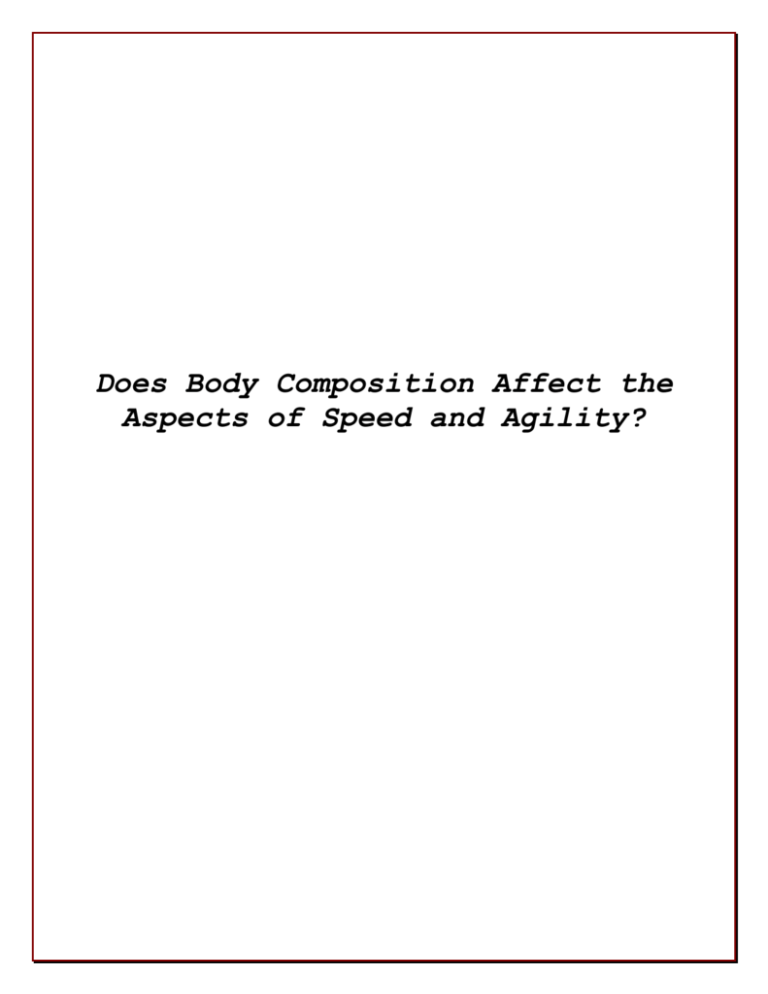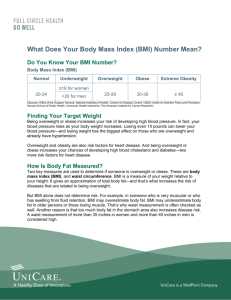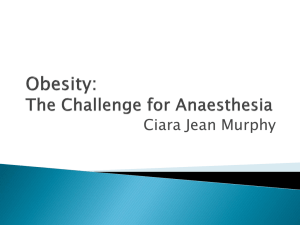Does Body Composition Affect the Aspects of Speed and Agility
advertisement

Does Body Composition Affect the Aspects of Speed and Agility? Introduction Obesity is a condition, which causes many health problems for youth. Data from the National Children and Youth Fitness Study II (NCYFS) indicated that obesity and superobesity had increased since the mid 20th century by 54% and 98% in children aged six to eleven years old (McManama & Schmottlach, 1997). A test is needed to determine if obese children have trouble with movement and everyday activities, which may cause a dislike to exercise. This lack of exercise in turn would put the now youth at considerable risk for a host of long-term health problems. A group of sixth grade students from Our Lady of Mount Carmel Elementary School were tested to determine if there is a relationship between body composition and speed/agility. Their body compositions were measured by using a body mass index (BMI) calculation. Then the students’ speed/agility was measured by a shuttle-run test. The researcher had expected to find a high positive correlation between the two tests. Thus, as the child’s weight goes up, it is expected that their shuttle-run times go up as well. Review of Literature This section contains information pertaining to the study being conducted. Therefore, the aspects of obesity, body composition, speed/agility tests, and relevant studies will be addressed. Obesity Obesity is defined as having an excess accumulation of fatty tissue in the body (Barrett, Jarvis, Kroger & London, 2002). The amount of excess fat that deems one as being obese is equal to 25% of body weight for males and 30% of body weight for females. Superobesity is defined as weighing more than 50% above ideal weight (Fishburne & Kirchner, 1998). The cause of obesity is complex. There is no one variable that can be held solely responsible. However, there are some causes that are more prevalent than others, which can be addressed through lifestyle changes. Improper diet is a common cause of obesity. Today, many children are eating foods that are dense in calories and low in nutrition. Another cause is the movement towards a sedentary lifestyle. Now, more than ever, children are inactive. An increase in movie/television watching, video game playing, and Internet use is the reason for this. To complicate this issue, over recent years there has been a reduction in mandatory physical education classes. It has been documented that only 36% of youth participate in physical activity in school on a daily basis (Buckanan, Dahl, Riben & Pizzey). Other possible causes of obesity include the following: glandular abnormalities (rare), hereditary, improper eating habits, insufficient physical activity, and psychosocial problems (Barrett, et al, 2002). Other than the possible inability to perform certain everyday activities with ease, the effects of obesity on the body are long-term and degenerative. They include such conditions as coronary heart disease, cancer, hypertension (high blood pressure), hyperlipidemia (high amount of fat in blood), diabetes, hypercholesterolemia (elevated cholesterol levels), orthopedic problems (due to excessive weight bearning on legs) and low back pain/injury (McManama & Schmottlach, 1997). The above conditions thrive on the psychosocial effect that obesity has on children. Due to their condition, obese children must exert a notably greater effort when engaged in activity. This produces reduced enjoyment in activity, which in turn leads to a reduction in effort. Thus, obese children burn fewer calories and remain overweight (Fishburne & Kirchner, 1998). Over the past twenty years, the number of children who are overweight has increased by more than 50% and the number of extremely overweight children has doubled (Virtua Health, 2001). Today obesity affects 1 in 5 children in the United States (Bucham, et al). It is estimated that the current generation of children will grow into the most obese generation of adults in United States History (Bucham, et al). That statistic is shocking when one considers that one third (approximately 58 million) are already overweight or obese. Aside from genetic factors and rare metabolic incidence of obesity, there is much that can be done to prevent or reverse this condition. These solutions are simple and include eating a proper diet and increase in physical activity. A proper diet entails eating nutritionally dense foods, which are low in fat. The caloric intake should also be taken into account. When trying to combat obesity, a healthy range of calorie intake should be between 1200 and 1500 calories per day (Barrett, et al). If a child if more than 40% overweight a physician or dietician run diet program should be considered (Virtua Health, 2001). The level of physical activity should be increased slowly until one reaches at least twenty to thirty minutes of vigorous exercise every day (McManama & Schmottlach, 1997). In addition, it is crucial that one should deal sensitively with obese children when exercising, to ensure that exercise sessions are positive (AAHPERD, 1999). This will help to make certain that exercise continues. It is imperative that prevention starts at a young age. Excessive calorie intake at a young age increases the number of fat cells one has. On average, the number of fat cells increases five fold until age 22 (Family Practice Notebook). A non-obese person has 25-30 billion fat cells, whereas an obese person has approximately 260 billion (Family Practice Notebook). Once fat cells develop they cannot be eliminated. Only the amount of fat in the cells can be decreased. Hence, if a child becomes obese, there is a greater chance that they will remain obese throughout adulthood. Body Composition Body composition is a health related fitness component. It is defined as the being the proportionate amount of total body mass that is lean (bone, muscle, organs, and tissues) or fat (adipose tissue) (Fishburne & Kirchner, 1998). There are several tests available to the physical educator, which can determine the body composition of an individual. Skinfold Caliper testing is the most accurate way of testing body composition for the physical education teacher. They also can be quite in expensive ranging from three to twenty dollars (Hawkins, 1983). The AAHPERD Health-Related Physical Fitness test suggests targeting the triceps and calf skinfolds. This should be done away from the main activity area of the class and no other students should be allowed to observe a child being measured (Fishburne & Kirchner, 1998). A second test is the Waist-to-Hip Ratio. This measurement came about due to research indicating that it is better to be pear shape than apple shaped. This is conducted by measuring a person’s waist at its smallest part and the hip at its largest part. Then the hip measurement is divided into the waist measurement to produce a ratio. Healthy ratios are deemed as being less than .86 in women and .95 in men (Fisburne & Kirchner, 1998). The Body Mass Index test is a ratio between height and weight using a mathematical formula that correlates with body fat (Fishburne & Kirchner, 1998). This formula is as follows: weight in kilograms divided by meters squared (Wood, 2001). A healthy range constitutes a body mass index of 20-25, an overweight range is 25-30, and obese is determined as being greater than 30 (Wood, 2001). The main advantage of this test is that it provides for a quick and simple calculation without having to come in close personal contact of students. The disadvantage of this test is that it can be inaccurate when measuring individuals with a great amount of muscle mass. However, this should not apply to the testing of youth since the majority of children do not start resistance training before adolescence (age 14 and over). Speed/Agility Tests Tests that measure both speed and agility involve participants moving at maximum with rapid stopping and/or turning (Wood, 2001). These tests are influenced by balance, coordination, position of center of gravity, and running speed. There are four major tests that measure both speed and agility. They are the Zig Zag test, Hexagon test, 505 Agility test, and the Shuttle run test (Wood, 2001). Norms for the 85th percentile of the shuttle run test for eleven year old youth are as follows: 10.3 seconds for boys and 10.6 seconds for girls (Hastad & Lacy, 1998). Relevant Studies A study was conducted on 80 elementary students grades one, two, and three to see if the factors of age, sex, and body composition were predictors of children’s performance on basic motor abilities and health related fitness components. In regard to body composition, the results indicated that individuals with large amounts of fat had a negative relationship with activities in which the body is projected through the air (Moore, Pissanos & Reeve, 1983). Furthermore, for any amount of work the obese person had greater energy expenditure, which forced the circulatory system to work harder (Moore, et al, 1983). Another study was conducted involving 563 elementary children to determine the relationship of body fatness and motor performance during pre adolescence. The results of this study indicated that there was only a marginal relationship with exception to moving one’s total body weight (East & Hensley, 1982). Testing Procedures and Methods Description of Subjects This study consisted of 29 sixth grade (ages 11-12) subjects form Our Lady of Mount Carmel Elementary School. The gender breakdown was fifteen males and 14 females. These subjects appeared to be relatively physically (within normal weight limits) fit with the exception of a few students. Tests Used for Study 1) Shuttle Run – Subjects run back and forth between a set distance of 30 feet two times. Each time they reach the 30 foot marker they will pick up an object and and return it to the starting line by placing it on the line (no dropping, throwing, etc.) Administrative Feasibility – This test is easy to administer. However, only one student can be tested at one time. This can lead to a great deal of inactivity time and possible class management problems. Psychometric qualities – Face Validity is assumed. Relability Coefficient ranges from .68 to .75 Source – AAHER, 1976 2) Body Mass Index – The subjects height and weight are recorded and converted into kilograms and meters. Then their weight in kilograms is divided by their height in meters squared. Administrative Feasibility – This is an easy way to calculate a general body composition of subjects. In addition, it eliminates personal contact with students, which may make both students and instructor uncomfortable. Psychometric qualities – Not available through given source. Source – AAHPERD – Physical Best Equipment tape measure (at least 15ft. to measure students and distance for shuttle run) stop watch bean bags (4 –8 depending upon number of practice stations) flat surface (black top preferable) weight scale scoring sheet chalk Administration of Tests 1) Shuttle Run Pretest Preparation – Prior to arriving at the test site, ten practice runs were completed by two subjects (not involved in study), which allowed the researcher to become accurate in timing the shuttle run.. The scoring sheet was prepared well ahead of time and was formatted to fit on a single page. This page included designated areas for the following: students name/number (located down the center), designated height and weight spaces (located to the left of each name), and a slot for shuttle run times (located to the right of each name). The testing site and two additional practice sites were then set-up on the black top outside of the school prior to the beginning of class. This was done by using a tape measure to measure the proper distance (30 feet) and chalk to mark the start line and the turning point. The width of each station was approximately fifteen feet. Two beanbags were placed at the thirty-foot markers (turning points) for each of the stations. Additional space was left for a fourth station aimed at occupying students who were neither practicing or testing. This very large station contained basketballs, footballs, and hula-hoops. When the students arrived, they were directed through their regular warm-ups. The students were then given standardized directions on how to complete the shuttle run, a self-demonstration, and a brief explanation as to why they were completing this activity. Testing procedure – The students were divided into four groups (approximately seven students per group) and placed at the four separate stations Everyone practiced running the shuttle run prior to testing. One person was tested at a time while the other members of the group formed a line to the side of testing area. In addition, the other members of the group were encouraged to cheer for the person being tested. The testing subject stood on the start line and began after the instructor gave the signal. Times were rounded to the nearest tenth. After the run was completed the shuttle run, he/she returned to the line and waited for the rest of the group to finish. Time allotment only allowed for one measurable trial. When the entire group had finished, they proceeded to the activity station. Then the next group rotated over to the testing area. This process continued until all students were tested. Posttest procedures – Students were brought together for a cool down period. This consisted of stretches and a question/answer session. Following the class, all materials were collected. 2) Body Mass Index Pretest preparation – Students lined up outside the nurse’s office. Testing procedures – Each student was weighed and measured privately in the nurse’s office using a standard scale with a height measure attachment. Posttest Procedures - When a student was finished being measured he/she returned to the classroom. * Note – The body mass index calculation was completed at a later date using the formula of weight in kilograms divided by height in meters squared. This was provided in an automatic calculation on line at http://www.stan-co.k12.ca.us/calpe/Sites.html. The results were rounded to the nearest tenth. Results The following chart represents a comparison the average time of shuttle run scores for subjects with a BMI of more than 25 and those with a BMI of less than 25. Chart 1 Comparison of Average Shuttle Run Scores Between BMI of Less Than 25 and BMI of More Than 25 16 13.8 12 Seconds 10.6 8 SR scores 4 0 BMI >25 BMI < 25 The following chart represents a comparison between total number of individual scores of the shuttle run test and the BMI test. Chart 2 Comparison Between BMI and SR Times 30 BMI SR Times 20 10 Subject Numbers 29 27 25 23 21 19 17 15 13 11 9 7 5 3 0 1 Value 40 This chart represents a positive correlation of .70 between the BMI of students and their shuttle run times. Chart 3 Correlation Chart Between BMI and SR Times SR Times 30 20 10 0 0 5 10 15 20 25 30 35 BMI This chart portrays a comparison of average shuttle run times and body mass index scores for boys vs. girls. Chart 4 Average Scores for Boys and Girls Girls SR Times BMI Boys 11.4 10.6 19.8 18.9 Results The group as a whole had an average body mass composition of 19.33, which was actually slightly under the healthy range of 20-25. The students mean score for shuttle run time was 10.95 seconds. This score varied minimally from the 85th percentile norm for sixth grade students, which was 10.3 seconds for boys and 10.6 seconds for girls. Other central tendency scores included a mode of 16.9 for BMI, mode of 10.2 for shuttle run, and ranges of 14.9 and 6.5 respectively. The Pearson calculation revealed a significant positive correlation of .70 between the variables of BMI and shuttle run times. Furthermore, a comparison of the average shuttle run scores between sub groups deemed as having BMI >25 and BMI <25 showed a 2.4 second difference. On average, the group with a BMI greater than 25 ran the shuttle run in 13.0 seconds as compared to 10.6 seconds for subjects with a BMI of less than 25. A comparison of the averages of boys vs. girls revealed only a minor difference in scores. Girls had both a slightly higher body mass index (19.8) and shuttle run times (11.4) as compared to the boys (18.9 and 10.6 respectively). Discussion As a whole, the subjects studied were of adequate body proportion (average BMI = 19.3) and motor ability (SR mean = 10.95). However, the statistical analysis does indicate that there is a significant positive relationship between body composition and speed/agility (chart 3coefficient = .70). Thus, a person’s body composition does affect their ability to run at a fast rate and maneuver quickly. This is also evidenced by the difference in shuttle run times, as shown by chart one, for students with >25 BMI and students with <25 BMI. In general, the more body fat a student had the slower they ran and maneuvered. This above data, if accurate, presents a concern for the American public and health educators in particular. These findings were in contradiction to an earlier study cited in this research, which indicated that body composition was only marginally related to motor activities. It could have been in fact that the study those researchers conducted did not contain subjects capable of skewing the results such as this research did (one eleven year old female tipped that scales at 170lbs). If obese/overweight children have a more difficult time moving, as indicated by the research, are they more likely to refrain from much needed exercise? If so, this suggests that (as other research indicates) the problem of overweight and obese children will reach epidemic proportions. This in turn will lead to a multitude of problems including poor health, shorter life expectancy, increased cost of health care, and possible decreased production in the work force. In regard to this study, there were many changes to need to be made to consider accuracy factors. First, a much larger sample is needed so that the results will not be able to be skewed from a few extreme scores. In addition, this sample should be more randomized. This will provide for a better overall representation. Next, this study should have been conducted using a more reliable method of testing body fat. BMI’s are infamous for reporting unreliable results, especially with muscular students. Finally, this study should have contained more than one motor performance variable. To truly determine if body composition inhibits overall physical performance they need to be tested in several different areas (ie. cardiovascular endurance). Future studies need to be conducted to determine the relationship between obese individuals and attitudes towards exercise. In addition, a research of exercise programs that are sensitive towards obese/overweight individuals needs to be completed to see which ones work and which ones do not.







